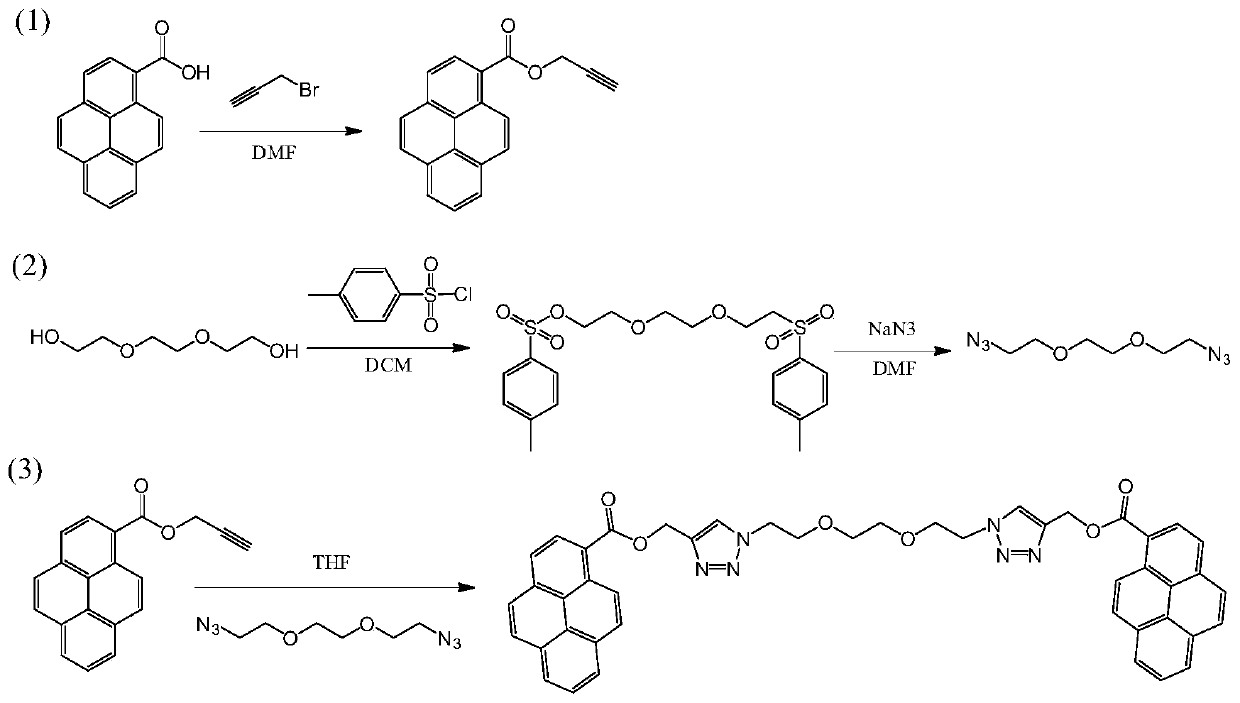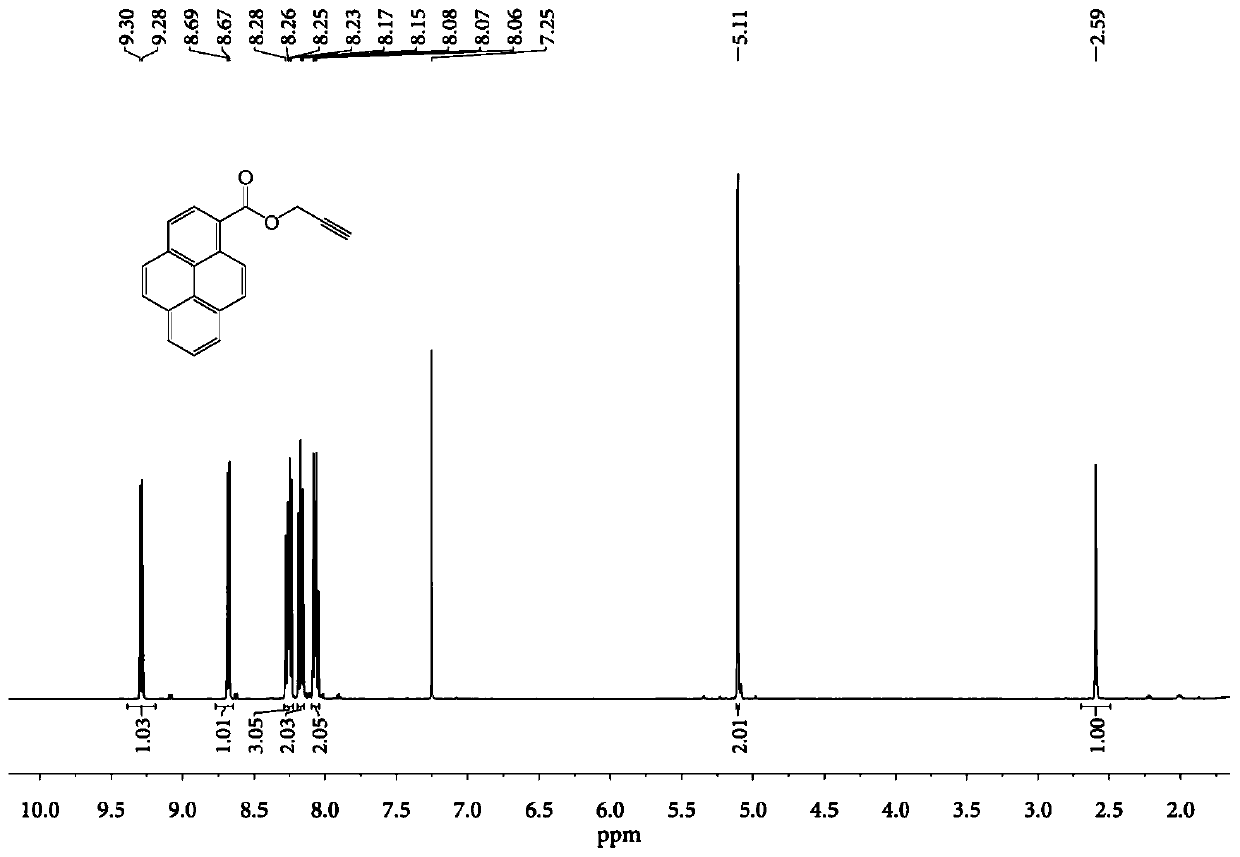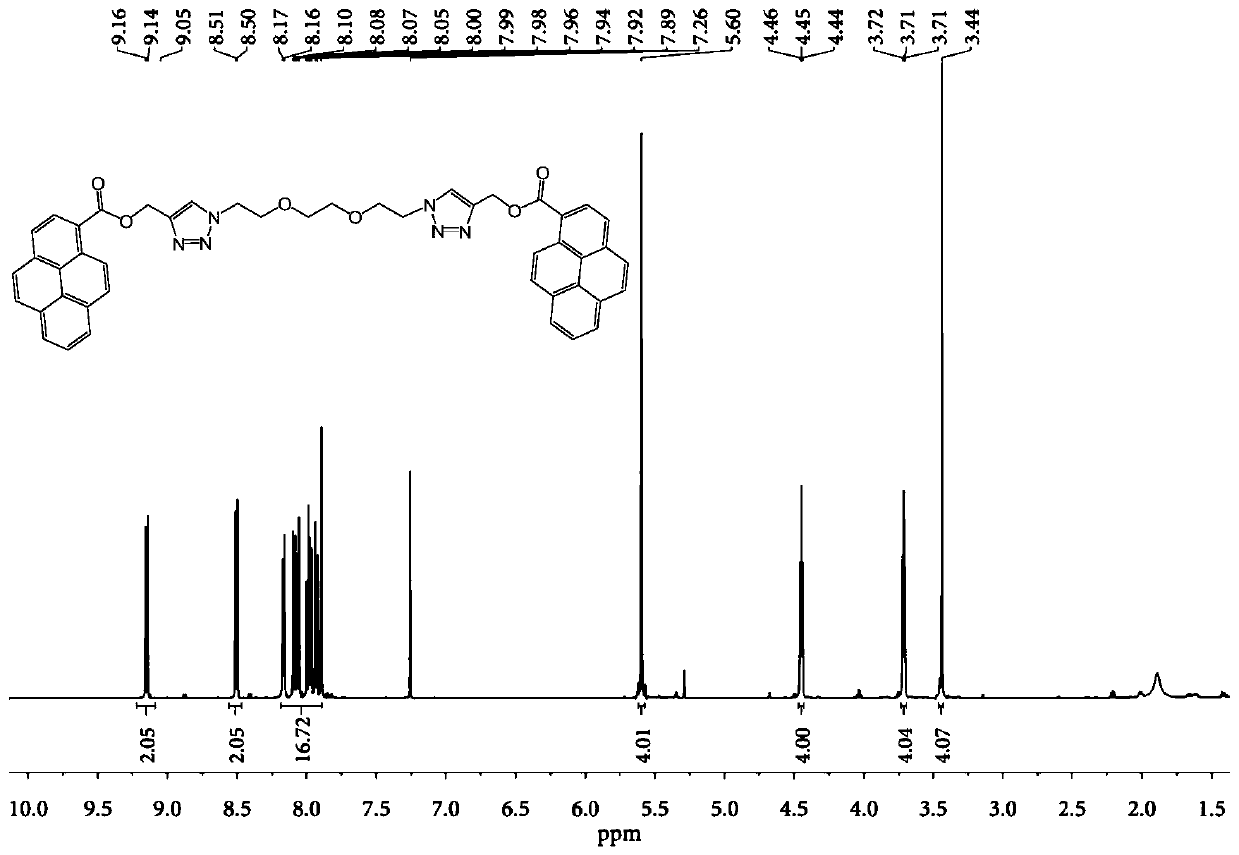A ratiometric fluorescent probe capable of simultaneously detecting silver ions and trivalent chromium ions and its preparation method and application
A fluorescent probe and ion detection technology, applied in the field of analysis and detection, to reduce the impact and improve the detection accuracy
- Summary
- Abstract
- Description
- Claims
- Application Information
AI Technical Summary
Problems solved by technology
Method used
Image
Examples
Embodiment 1
[0036] Embodiment 1: Preparation process 1 of fluorescent probe
[0037] 1) Dissolve 186mg of 1-pyrenecarboxylic acid (0.75mmol) in 0.75mL of N,N-dimethylformamide, add 132mg of 3-bromopropyne (1.125mmol) and 154mg of potassium carbonate (1.125mmol), and control the reaction temperature at 80°C, stirred and reacted for 5 hours; cooled to room temperature, added 20 mL of deionized water, extracted with 100 mL of ethyl acetate, collected the organic phase, washed with brine (50 g / L), dried with 100 mg of anhydrous sodium sulfate, and filtered The organic solvent was removed by rotary evaporation, and the resulting solid was purified by silica gel chromatography (eluent: sherwood oil / dichloromethane, V / V=4:1) to obtain white solid 1-pyrenecarboxylate-1-propynyl ester ( The productive rate is 93.0%); The product is characterized by NMR 1 H NMR (CDCl 3 ,600MHz,δppm):9.28-9.30(d,1H),8.65-8.70(d,1H),8.23-8.28(q,3H),8.15-8.19(t,2H),8.04-8.09(q,2H) , 5.11-5.13 (d, 2H), 2.58-2.60 (t,...
Embodiment 2
[0041] Embodiment 2: the preparation process flow 2 of fluorescent probe
[0042] 1) Dissolve 93mg of 1-pyrenecarboxylic acid (0.375mmol) in 0.66mL of N,N-dimethylformamide, add 88.4mg of 3-bromopropyne (0.75mmol) and 128mg of potassium carbonate (0.94mmol), and control the reaction temperature Stir the reaction at 92.5°C for 6 hours; cool to room temperature, add 10 mL of deionized water, extract with 50 mL of ethyl acetate, collect the organic phase, wash the organic phase with brine (50 g / L), and dry with 50 mg of anhydrous sodium sulfate. Filtration; the organic solvent was removed by rotary evaporation, and the resulting solid was purified by silica gel column chromatography (eluent: petroleum ether / dichloromethane, V / V=4:1) to obtain a white solid 1-pyrenecarboxylate-1-propynyl ester (92.1% yield).
[0043] 2) Take 217mg of triethylene glycol (1.45mmol) and dry it in an oven at 107.5°C for 2.5 hours, dissolve it in 25.4mL of dichloromethane, add 0.66g of 4-dimethylamino...
Embodiment 3
[0047] Embodiment 3: the preparation process flow 3 of fluorescent probe
[0048] 1) Dissolve 232.5mg of 1-pyrenecarboxylic acid (0.938mmol) in 2.4mL of N,N-dimethylformamide, add 276mg of 3-bromopropyne (2.35mmol) and 472mg of potassium carbonate (3.28mmol), and control the reaction temperature Stir the reaction at 105°C for 7 hours; cool to room temperature, add 25 mL of deionized water, extract with 125 mL of ethyl acetate, collect the organic phase, wash the organic phase with brine (50 g / L), and dry with 125 mg of anhydrous sodium sulfate. Filtration; the organic solvent was removed by rotary evaporation, and the resulting solid was purified by silica gel column chromatography (eluent: petroleum ether / dichloromethane, V / V=4:1) to obtain a white solid 1-pyrenecarboxylate-1-propynyl ester (93.5% yield).
[0049] 2) Take 542.5mg of triethylene glycol (3.62mmol) and dry it in an oven at 120°C for 3 hours, dissolve it in 72mL of dichloromethane, add 1.9g of 4-dimethylaminopyr...
PUM
 Login to View More
Login to View More Abstract
Description
Claims
Application Information
 Login to View More
Login to View More - R&D
- Intellectual Property
- Life Sciences
- Materials
- Tech Scout
- Unparalleled Data Quality
- Higher Quality Content
- 60% Fewer Hallucinations
Browse by: Latest US Patents, China's latest patents, Technical Efficacy Thesaurus, Application Domain, Technology Topic, Popular Technical Reports.
© 2025 PatSnap. All rights reserved.Legal|Privacy policy|Modern Slavery Act Transparency Statement|Sitemap|About US| Contact US: help@patsnap.com



